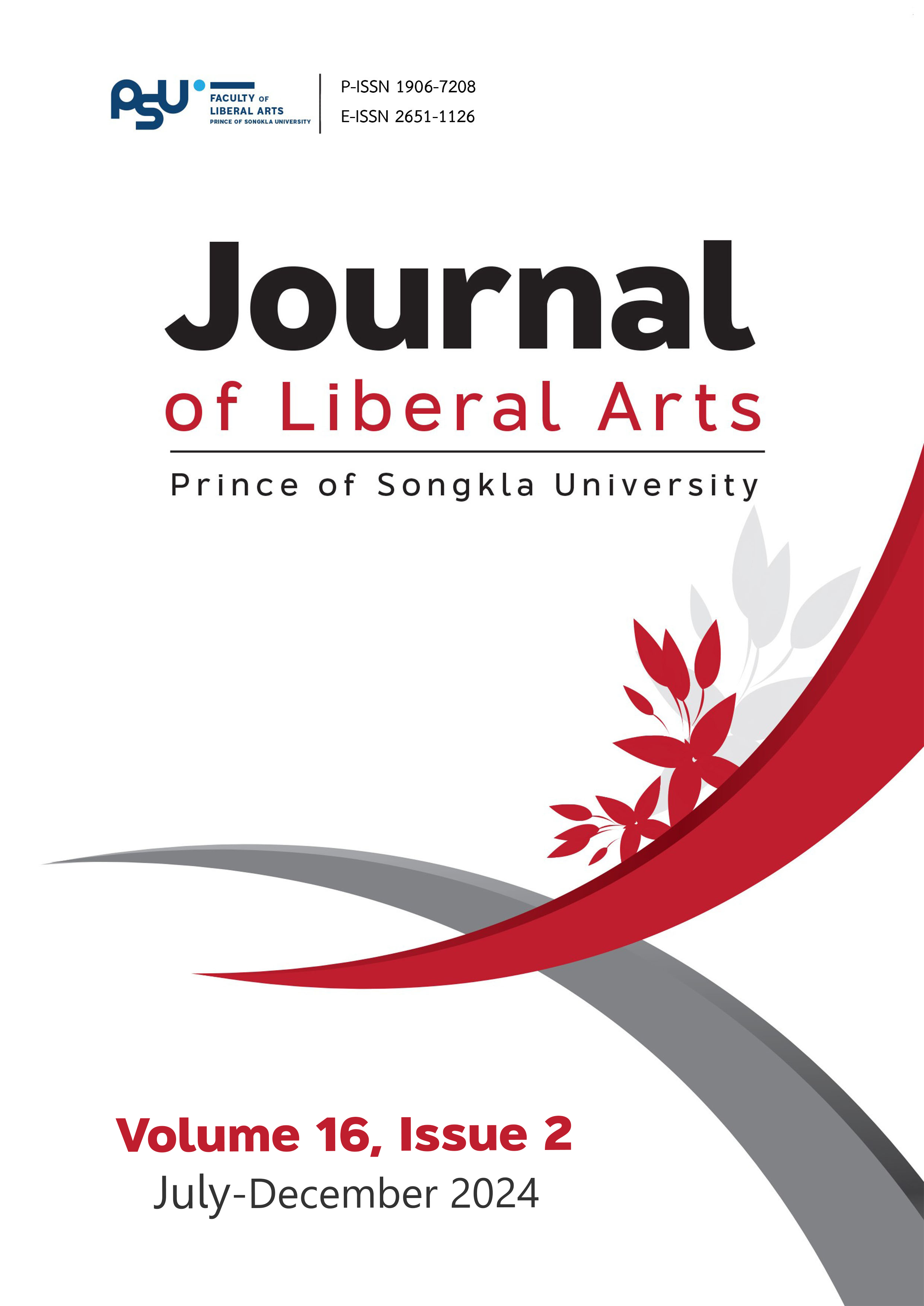การสร้างชุมชนและกระตุ้นการขาย: อิทธิพลของความเป็นพวกพ้องในตลาดออนไลน์มหาวิทยาลัย
DOI:
https://doi.org/10.14456/jlapsu.2024.14คำสำคัญ:
ความเป็นพวกพ้อง , วาทกรรมความเป็นพวกพ้อง , ตลาดออนไลน์มหาวิทยาลัย , การตัดสินใจซื้อของผู้บริโภค , คำบรรยายการขายบทคัดย่อ
การวิจัยนี้มีวัตถุประสงค์เพื่อศึกษาการสร้างและใช้ความเป็นพวกพ้องเพื่อสนับสนุนการขาย รวมทั้งอิทธิพลของความเป็นพวกพ้องต่อการตัดสินใจซื้อในหมู่สมาชิกตลาดออนไลน์ของมหาวิทยาลัยแห่งหนึ่งในประเทศไทย ตลาดออนไลน์แห่งนี้ริเริ่มโดยศิษย์เก่าเพื่อตอบสนองต่อการแพร่ระบาดของโควิด-19 โดยทำหน้าที่เป็นชุมชนที่แก้ไขปัญหาและกระตุ้นการมีส่วนร่วมของสมาชิกในองค์กร การวิจัยนี้ศึกษาลักษณะวาทกรรมความเป็นพวกพ้องในการสร้างเสริมความเป็นปึกแผ่นของชุมชนผ่านทฤษฎีวาทกรรมความเป็นพวกพ้องของอัลฮัม ฮัลฮาบี รวมทั้ง
กลยุทธ์ทางการตลาดเฉพาะที่สัมพันธ์กับความเป็นพวกพ้อง ผู้วิจัยเก็บข้อมูลจากคำบรรยายการขายออนไลน์จำนวน 120 ข้อความเพื่อวิเคราะห์วาทกรรมความเป็นพวกพ้องและผลสำรวจออนไลน์จากสมาชิกชุมชนจำนวน 400 รายเพื่อวิเคราะห์อิทธิพลของความเป็นพวกพ้องและสถานะของผู้ขายต่อการตัดสินใจซื้อของผู้บริโภค ผลการศึกษาพบวาทกรรมความเป็นพวกพ้องทั้ง 5 วัจนกรรม ได้แก่ วัจนกรรมผูกมัด วัจนกรรมยืนยัน วัจนกรรมระบุ วัจนกรรมจัดกลุ่มใหม่ และวัจนกรรมโน้มน้าว รวมทั้งประเมินผลกระทบที่ปรากฏต่อการตัดสินใจซื้อของผู้บริโภค และประเมินอิทธิพลของสถานะผู้ขาย นอกจากนี้การวิจัยยังพบว่าอิทธิพลของความเป็นพวกพ้องต่อการตัดสินใจซื้อของผู้บริโภคมีหลายระดับ อันนำไปสู่ข้อมูลเชิงลึกในแง่ประสิทธิผลของกลยุทธ์ความเป็นพวกพ้องที่แตกต่างกันในการส่งเสริมความสามัคคีของกลุ่มและสนับสนุนเป้าหมายทางธุรกิจ การวิจัยนี้ช่วยเพิ่มความเข้าใจต่อพลวัตของชุมชนออนไลน์และผลกระทบต่อการตลาดและการตัดสินใจซื้อของผู้บริโภคในช่องทางดิจิทัล
References
Alharbi, A. (2018). Towards a performative theory of solidarity discourse. Cogent Arts & Humanities, 5(1). https://doi:10.1080/23311983.2018.1495044 Alharbi, A., & Rucker, M. (2023). Discursive practices of the performative theory of solidarity discourse. Language Sciences, 95. https://doi:10.1016/j.langsci.2022.101515
Austin, J. L. (1962). How to do things with words. Oxford University Press.
Baumeister, R. (2012). Need-to-Belong Theory. In P. A. Van Lange, A. W. Kruglanski & E. T. Higgins (Eds.), Handbook of theories of social psychology: Volume 2 (pp. 121–140). SAGE Publications Ltd. https://doi.org/10.4135/9781446249222
Facebook Community. (2018). Discover new badges to recognize admins and outstanding members. Facebook. https://www.facebook.com/community/whats-new/facebook-group-badges/
Georgiou, M. (2016). Facebook page or group - Which is better for your business?. SocialMediaToday. https://www.socialmediatoday.com/social-networks/Facebook-page-or-group-which-better-your-business
Hechter, M. (1987). Principles of group solidarity. University of California Press.
Hechter, M. (2001). Solidarity, sociology of. International Encyclopedia of the Social & Behavioral Sciences, 14588–14591. https://doi:10.1016/b0-08-043076-7/01969-0
Kulow, K., Bentley, K., & Rajagopal, P. (2021). Together we stand: The solidarity effect of personized sellers on essential workers. Journal of the Association for Consumer Research, 6(1), 178–186. https://doi.org/10.1086/711731
Lestari, M., & Wahyono, W. (2021). The influence of celebrity endorser and online promotion on purchase decision through brand image. Management Analysis Journal, 10(2), 198–211. https://doi.org/10.54408/jabter.v2i6.199
Mulyana, A., Briandana, R., & Puspa, D. A. (2019). Social construction fandom as cultural industry marketing of JKT 48 Fan group. International Research Journal of Business Studies, 12(3), 257–266. https://doaj.org/article/90de924cc5294e2a9aaf2e2c19743e88
Prainsack, B., & Buyx, A. (2011). Solidarity: Reflections on an emerging concept in bioethics. ESP Colour Ltd. https://www.nuffieldbioethics.org/assets/pdfs/Solidarity-report.pdf
Prainsack, B., & Buyx, A. (2017). Solidarity in biomedicine and beyond. Cambridge University Press.
Rubin, R. B., Palmgreen, P., & Sypher, H. E. (2004). Communication research measures: A sourcebook (1st ed.). Routledge.
Sam, M. S. (2013). Group solidarity. Psychology Dictionary. https://psychologydictionary.org/group-solidarity/
Sanguankaew, S., Laeheem, K., Dhammasaccakarn, W., & Jeawkok, J. (2020). Bpatjai thee mee bohtbaat samkhan thee tham hai geert khwaamcheuuamnaaen thaang sangkhohm. (in Thai) [Important role factors affecting social cohesion]. Journal of Liberal Arts, Maejo University, 8(1), 194-261.
Taibanguai, K., (2022). Attentional capture strategies: A multimodal discourse analysis of online selling posts and its impacts on viewers [Unpublished master’s thesis]. Mahidol University.
Taibanguai, K., & Suraratdecha, S. (2022). Strategies to grab attention: A multimodal discourse analysis of online selling posts. NIDA Journal of Language and Communication, 27(42), 47-67.
Fisse, T., & Haas, C. (2020). Covid-19 and true solidarity on the internet – digital society blog. HIIG. https://www.hiig.de/en/covid-19-and-true-solidarity-on-the-internet/
Unger, S. H. (2014). The need for solidarity. http://www1.cs.columbia.edu/~unger/articles/solidarity.html
World Bank. (2022). COVID-19 to plunge global economy into worst recession since World War II. World Bank Group. https://www.worldbank.org/en/news/press-release/2020/06/08/covid-19-to-plunge-global-economy-into-worst-recession-since-world-war-ii
Yamane, T. (1967). Statistics: An introductory analysis (2nd ed.). Harper and Row.
Yan, B., Zhang, X., Wu, L., Zhu, H., & Chen, B. (2020). Why do countries respond differently to COVID-19? A comparative study of Sweden, China, France, and Japan. American Review of Public Administration, 50(6–7), 762–769. https://doi:10.1177/0275074020942445.
Downloads
เผยแพร่แล้ว
How to Cite
ฉบับ
บท
License
Copyright (c) 2024 Kittima Taibanguai, Sumittra Suraratdecha

This work is licensed under a Creative Commons Attribution-NonCommercial-NoDerivatives 4.0 International License.
ลิขสิทธิ์บทความเป็นของผู้เขียน แต่วารสารศิลปศาสตร์ มหาวิทยาลัยสงขลานครินทร์ ขอสงวนสิทธิ์ในการเป็นผู้ตีพิมพ์เผยแพร่เป็นครั้งแรก




